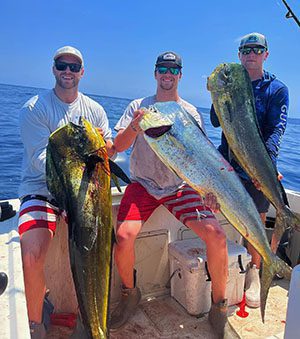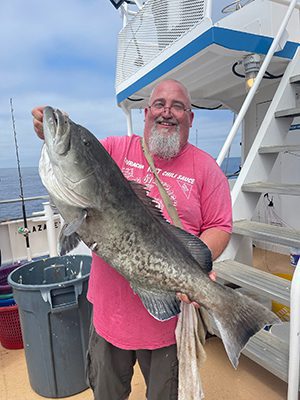Morehead City/Atlantic Beach – July 2022
Damien, of Chasin’ Tails, reports that red drum, speckled trout, flounder, and black drum are being found around just about any of the inshore structures. Anglers are having the best success while targeting the areas with deeper ledges near docks and rocks or oyster structure.
Sheepshead are also in these same areas and are best caught by anglers using live fiddler crabs or other shelled baits.
Anglers fishing the marsh grasses during higher tide cycles are finding a variety of red drum, speckled trout, and flounder. Topwater plugs and spoons have worked well early when conditions allow, with live baits and soft plastics also enticing strikes.
Spanish mackerel and bluefish are schooled up just about everywhere from the inlets, out along the surf zone, and out to the nearshore ARs. Anglers are catching these fish by casting metal jigs to the surface-feeding schools or by trolling. Live baits have generated some of the bigger spanish mackerel, but the classic Clarkspoon and planer combo will produce plenty of action.
A few king mackerel are being caught out in the 7+ mile range. Most of these schools have pushed into this area with warm water moving in close.
Bottom fishing anglers are finding a good grouper bite out in the 30+ mile range.
Out in the Gulf Stream, anglers are catching gaffer-sized mahi, a few scattered wahoo, and blue marlin. Some mahi have started pushing inshore, though, with warm water pulling fish away from the break. Anglers have been catching some fish out towards the 14 Buoy, though most of these nearshore fish have been scattered and smaller peanut-sized, as compared to the ones further offshore.

Tanner Tolston, Gunner Tolston, and Camden Driver hooked these mahi on skirted ballyhoo while trolling 50 miles off Beaufort Inlet.
Joe, of Carolina Traditions Guide Co., reports that there are a lot of big spanish mackerel being caught nearshore. Anglers fishing live baits have had most of the success.
King mackerel are still around, with most fish being caught closer to the beach being small to medium-sized.
Schools of bluefish are scattered out around the shoals off Cape Lookout.
Bottom fishing has been producing black sea bass, ring tails, and triggerfish from 30-40’ on out.
Red drum action is really good with summer fishing now in full swing. There is a wide variety of live bait around; shrimp, mullet, and menhaden are all enticing strikes from the reds. Most of these smaller groups are pushed shallow onto grass flats or around oysters to avoid boat traffic and fishing pressure.
A few speckled trout are holding, though the warmer water has fish scattered.
Plenty of nice flounder are being caught and returned to structured areas they are staged on.
Anglers fishing smaller cut baits in deeper holes around the Turning Basin are catching large sea mullet and gray trout.
Daniel, of On Deck Fishing Charters, reports that the spanish mackerel are plentiful along the beaches. Anglers will find action while both casting jigs at feeding schools and slow-trolling live baits. Generally, the live bait anglers are hooking the bigger spanish hanging around.
Inshore anglers are finding red drum in their summer patterns where they scatter just about everywhere. Anglers will find strikes with a wide variety of tactics from topwater plugs and popping corks to fishing Gulp soft plastic on heavier jig heads.
Anglers on the water early will be finding a few speckled trout up on the grass flats with topwater plugs.
Flounder will be mixed in the action just about anywhere baits are fished on the bottom.
Chris, of Mount Maker Charters, reports that nearshore anglers have been catching king mackerel, cobia, and gag groupers on live bottoms to the SE of Beaufort Inlet. The 65-120’ range has been the zone to target, with most of the success coming off live bait.
Spanish mackerel, bluefish, and sharks are staged up from deeper areas of the inlets out along the beachfronts.
Inshore anglers are seeing steady action on slot and over-slot red drum, with a few really nice-sized speckled trout also in the mix.
Justin, of Breakday Charters, reports that inshore anglers have been finding good action on both red drum and speckled trout throughout the ICW. In typical summertime fashion, these fish are staged up around hard structures such as docks and jetties.
Moving into the later parts of July, large red drum will become more common place in the sound around Cedar Island and moving up into the lower Neuse.
Nearshore anglers have found plenty of large spanish mackerel around while slow-trolling and free-lining live finger mullet or menhaden.
King mackerel are scattered after their initial springtime push nearshore, but the schools will get thicker going towards fall.
Further off the beach, anglers fishing the 15-25 mile range will be catching king mackerel and a few mahi that are pushed in from the break.
Summer is a great time to target big amberjacks over nearshore wrecks with topwater poppers, and bottom fishing out in the 80’+ range is producing good-sized vermilion snapper and triggerfish.

Jon Kortze, of Greenville, hooked this 22.5 lb. citation gag grouper on a pinfish 34 miles southwest of Beaufort Inlet. He was fishing with Capt. Wayne Dodson on the Carolina Princess.
Byron, of Going Bogue Outdoors, reports that the summertime mahi pushing nearshore are starting to show their typical pattern as they tend to during these hotter summer months. Anglers are finding fish around, but many are smaller, and with these scattered groups, the bite can feel very sporadic.
Further offshore, the same could be said for wahoo.
Bottom fishing has produced good gag grouper action as they move their way closer to the beaches. Anglers have been able to find some good fish in waters around structure as shallow as 45’.
Triggerfish and vermilion snapper are also moving over these nearshore bottom areas.
Jessica, of Oceanana Pier, reports that there has been a decent spanish mackerel bite, with larger fish (to 5+ lbs.) in the mix.
There are also plenty of bluefish schools moving around the pier. Both the blues and spanish action has been best on the tide changes and during times of cleaner water.
Bottom fishing has been pretty good despite warmer water along the beach. Anglers are catching a mixed bag of sand perch, croakers, hogfish, spots, and spadefish while fishing smaller bottom-rigged cut shrimp, sand fleas, or artificial strip baits.
